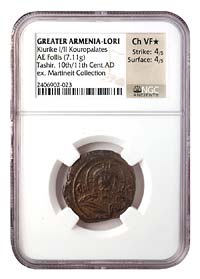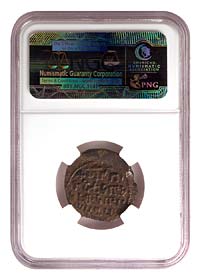NGC Ancients Grades Armenian Rarity
Posted on 7/7/2009
It was Richard Martineit’s good fortune to be at that auction in October, 2007, where more than 1500 lots were sold in two days. One that caught his eye was lot 1597, a group of 13 coins in a box labeled "Roman & Ancient pieces". It contained a variety of silver and base metal coins issued from the 3rd Century B.C. to the 11th Century A.D. Highlights included a Roman silver denarius of 41 B.C. with the portraits of warlords Marc Antony and Octavian, and three coins struck by Greek and Roman rulers of Egypt.
Seeking proper identifications and grading, Martineit sent his coins to NGC Ancients, a branch of the Numismatic Guaranty Corporation (NGC) dedicated to coins of the ancient world. On his submission form, the last three coins were described by the submitter as issues of the Byzantine Empire. Each had an image of Christ on the obverse and an inscription on the reverse. It was soon discovered that only two of them were Byzantine, and one in fact was Armenian.
The prize coin was an Armenian bronze follis of "Kiurike the Kouropalates" from the 10th or 11th Century A.D. Modeled after contemporary coins of the Byzantine Empire, it belongs to the first coinage with Armenian inscriptions. Martineit’s example is perhaps the finest of the 19 known, and its inscription has an unusual arrangement that until now may not have been documented.
"Even through I owned that box lot for 15 months I never looked at the three coins I identified as Byzantine until I mailed them to NGC," Martineit says. "In fact, I bought the lot for the other coins and I was not going to send in those three coins until I realized I could never find a value for them until I knew what they were. So I added them to the submission at the last minute."
As it turns out, one of these three coins was a hidden treasure.
"At first glance it appeared to be an ordinary Byzantine bronze," says David Vagi, director of NGC Ancients, "but when I turned it over I knew it was something I had never handled before." Vagi consulted with Robert W. Hoge, a curator at the American Numismatic Society, who confirmed its importance.
Martineit was overwhelmed when he got the news: "To say the least, David made my day with his phone call," he says. "I cannot tell you how happy I am about this stroke of luck. I feel like a kid who just got the greatest train set it the world and cannot stop playing with it. NGC's service went light years beyond anything I ever expected."
Without proper identification, the Armenian coin might have remained unknown until it entered the marketplace as an ordinary Byzantine coin, valued at perhaps $50. "This is the kind of thing you expect to see on Antiques Roadshow – a discovery that makes what we do so rewarding. We normally do not grade Medieval Armenian coins, but this case was so unusual that we made an exception," Vagi adds.
Originally, the surface of the coin was partly covered with encrustation. David Hendin, an expert in coin conservation, was enlisted as an outside consultant to help reveal the full detail of the coin. Conservation was especially important since the coin was a condition rarity, and the inscription needed to be fully visible.
The precise attribution of the coin is debated since it contains no indication of date or mint. Authorities generally agree that it is from Lori, a region in northeastern Greater Armenia, and that it likely was struck in the city of Tashir.
The inscription, which is the earliest appearance of Armenian language on a coin, translates to "May God aid Kiurike the Kouropalates," and shows that the issuer claimed the title Kouropalates ("charge of the palace"), a rank awarded by Byzantine emperors to vassal rulers of Armenia. However, scholars are sharply divided over which Kiurike issued the coin, some preferring the dynast Kiurike I (c. A.D. 979-989) and others his grandson Kiurike II (c. A.D. 1048-1100).
For more information about NGC Ancients, visit www.ngccoin.com/ancients online. NGC Ancients can be contacted at 1-800-NGC-COIN (642-2646) or by email at ancients@ngccoin.com.
Stay Informed
Want news like this delivered to your inbox once a month? Subscribe to the free NGC eNewsletter today!


